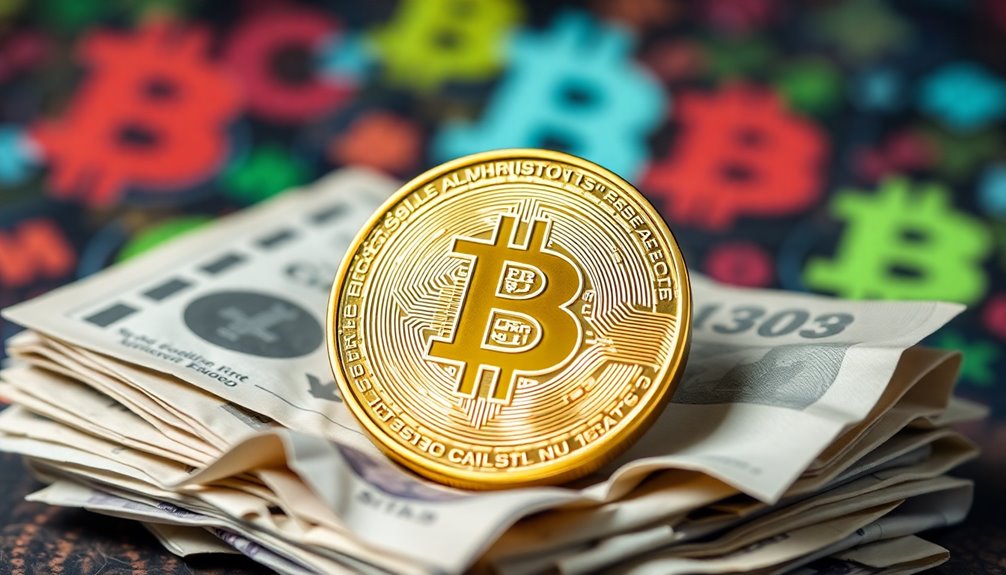EU banks are actively testing tokenized deposits under the MiCA regulation to modernize banking services, improve transaction speed, and guarantee compliance with new digital asset laws. These pilots aim to enhance cross-border transfers, boost transparency, and strengthen security. As banks work to integrate blockchain technology with traditional systems, they focus on overcoming regulatory hurdles and technological challenges. Keep exploring to discover how these efforts could reshape the future of banking for depositors.
Key Takeaways
- EU banks are conducting pilot programs to test tokenized deposits within the framework of the MiCA regulation.
- These pilots aim to evaluate integration of blockchain-based digital funds into existing banking systems.
- The initiatives focus on enhancing transaction security, reducing settlement times, and improving cross-border transfers.
- MiCA regulation provides a clear legal framework to ensure tokenized deposits are secure, transparent, and compliant.
- Successful pilots could lead to broader adoption of digital currencies, transforming traditional banking and asset management.

Are EU banks ready to revolutionize how you manage your deposits? With the recent pilot programs involving tokenized deposits under the new MiCA regulation, the landscape of banking is set to transform. Tokenized deposits are digital representations of traditional funds stored securely on blockchain networks, promising faster transactions, enhanced transparency, and potentially lower costs. As a consumer, you might soon experience a banking system where your savings are not just numbers on a screen but digital currencies that can be transferred instantly across borders. This shift could lead to more accessible financial services, making it easier for you to move money and manage your assets in real time.
EU banks are piloting tokenized deposits, promising faster, more transparent, and borderless banking experiences for consumers.
However, integrating digital currency into deposit systems isn’t without its hurdles. One of the biggest challenges facing these innovations is steering through the complex web of regulatory challenges that come with digital currencies. Financial authorities are cautious, aiming to protect consumers and maintain financial stability while fostering innovation. The MiCA regulation, which stands for Markets in Crypto-Assets, aims to create a clear legal framework for digital assets, including tokenized deposits. By doing so, regulators want to ensure these new forms of money are secure, transparent, and reliable. For you, this means that your deposits will be subject to strict oversight, reducing risks of fraud or insolvency, while enabling the benefits of blockchain technology.
Despite the regulatory challenges, EU banks are actively experimenting with tokenized deposits to test their viability. These pilots are designed to evaluate how digital currencies can be integrated seamlessly into existing banking infrastructure. The goal is to create a system that combines the efficiency of blockchain technology with the security standards you expect from traditional banks. As a depositor, you could soon enjoy quicker access to your funds, reduced settlement times, and improved transaction security—all while complying with evolving regulations that prioritize your protection.
The pilot programs are also addressing issues like cross-border transfers and interoperability between different digital currencies. This means your deposits could become more versatile, allowing you to send money across EU countries with minimal friction. Yet, challenges remain in ensuring that these digital currencies are resilient against cyber threats and that regulatory frameworks adapt swiftly to technological advances. As these innovations develop, your experience as a customer will likely evolve, with banks offering more innovative, digital-first services. Additionally, advances in projected technology adoption will further shape how these systems operate in the near future.
In short, while EU banks are making significant strides with tokenized deposits under the MiCA regulation, the journey is still ongoing. The push towards digital currency integration promises a more efficient, transparent, and accessible banking future—if regulatory challenges can be effectively managed. As a bank customer, you stand to benefit from a system that’s faster, safer, and more aligned with the digital age, provided these pilots successfully steer through regulatory and technological hurdles.
Frequently Asked Questions
How Will Tokenized Deposits Impact Traditional Banking Stability?
Tokenized deposits could boost banking stability by making transactions more efficient and transparent. You’ll need strong cybersecurity measures to protect digital identities and prevent fraud. While it offers faster, more secure access to funds, it also introduces new risks if safeguards aren’t in place. By integrating digital identity verification and robust security protocols, you can help guarantee the stability of traditional banking systems amid these digital innovations.
What Are the Consumer Protections for Tokenized Depositholders?
Think of your digital identity as a shield, protecting your interests. Regulatory compliance guarantees that tokenized depositors like you receive safeguards such as deposit insurance, transparency, and dispute resolution mechanisms. These protections help prevent losses and build trust, making sure your digital deposits are secure. By adhering to strict standards, banks prioritize your safety, ensuring that your assets are protected under the law and that you can confidently navigate the evolving digital banking landscape.
How Will Cross-Border Transactions Be Affected by This Pilot?
You’ll find that cross-border transactions become more efficient with this pilot, thanks to digital currency use. It streamlines processes, reduces settlement times, and lowers costs across borders. As a depositor, you benefit from faster, more reliable transfers, making international banking smoother. This initiative enhances cross-border efficiency, encouraging broader adoption of digital currency solutions, which ultimately simplifies your global banking experience and promotes seamless transactions across different jurisdictions.
What Specific Technologies Are Involved in Tokenizing Deposits?
Think of the technology involved as a digital lock and key system. You use blockchain technology to securely record and verify transactions, ensuring security and transparency. Digital identity tools confirm users’ identities, preventing fraud. These systems work together like a sturdy vault, safeguarding deposits as they’re converted into tokens, making transactions faster and more secure. This integration enhances trust and efficiency in the tokenized deposit process.
When Will Tokenized Deposits Become Available to the General Public?
Tokenized deposits could become available to the public within the next year or two, once regulatory approvals and technological implementations are finalized. You’ll be able to access them securely thanks to blockchain security features, which guarantee data integrity and transparency. Digital identity solutions will also help verify your identity smoothly, making the process seamless. Keep an eye on regulatory updates, as they’ll determine the exact rollout timeline for wider adoption.
Conclusion
As you watch the EU banks pilot tokenized deposits under the MiCA regulation, it’s clear this innovation could reshape banking. With over 80% of financial institutions expressing interest in digital assets, the move signals a shift toward modernization. Tokenized deposits could boost efficiency and accessibility, transforming your banking experience. Embracing these changes now positions you at the forefront of a rapidly evolving financial landscape, where digital assets become an integral part of your future transactions.








